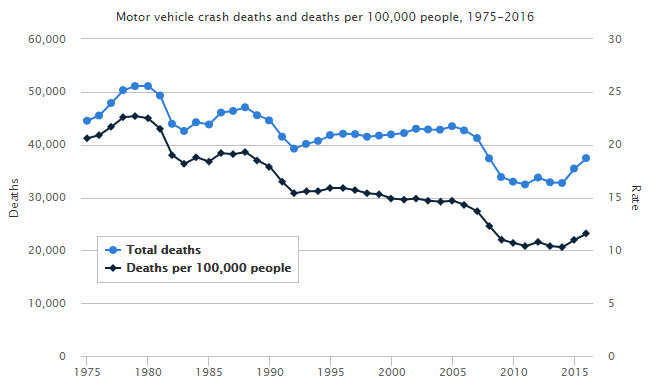Death by Text...or Other Distraction

As we approach the Memorial Day weekend, a huge percentage of people will be travelling across the country to visit family and friends. More traffic means more risk, so share this with the people you want to see “arrive alive.”
According to a 2016 Everquote survey, 96% of drivers surveyed think they are safe drivers. Conversely, 86% of those same drivers responded that they disagree or are neutral when asked if the majority of drivers on the road are safe behind the wheel. In a nutshell, drivers seem to think they operate safely themselves, but that others are not so safe. 61% of those drivers also admitted to using a cell phone while driving in the past 30 days.
So what does all this mean? Consider what has happened to the traffic fatality numbers in the last few years. An estimated 40,100 people died in traffic accidents in 2017. We had experienced nearly a decade of annual decreases in fatalities with the lowest in 2011 at 32,479. We are now seeing fatalities increase each year despite progress in automotive technology and survivability. Note that increase in the chart below:

Source: Insurance Institute for Highway Safety, Highway Loss Data Institute
What would explain the increase in fatalities the last few years? This total includes a significant increase in pedestrian and bicyclist fatalities as well, not just drivers and passengers. Could distraction be the answer? Are we so tied to our cell phones that we are forgoing safety in favor of more production or constant connectivity?
The statistics and survey results above likely mean the average driver simply isn’t aware of how hazardous it is to use a cell phone while driving. Or they may simply think they are more capable than “the other guy” when it comes to operating a vehicle and using an electronic device at the same time. The truth is we, as human beings, cannot do both tasks at the same time. Our brain has to “time share” as it rapidly moves from one thought to the next. That’s not a problem when sitting on the couch in front of the TV and zipping through social media posts on a phone while listening to a friend’s conversation about his cat. But it is a problem if that same person is behind the wheel of a moving vehicle when a second of distraction can mean disaster. Keep in mind that a car moving at 65 mph is travelling almost 100 feet per second, and that it can take nearly the length of a football field to stop that car.
Does your organization require employees to follow an electronic device policy while driving? If there is such a policy, is it enforced with every worker? According to the Society for Human Resource Management distracted driving policies save lives and protect organizations. Consider the following from the National Safety Council:
Organizations that fail to create and enforce policies prohibiting employees from using their phones while driving put workers in jeopardy and increase employer liability, according to the National Safety Council (NSC).
“We live in a very connected world,” said Deborah Hersman, CEO and president of the NSC. “Many of us find it hard to disconnect from work when we are away from the office, and … it begs the question: What is the cost of constant connectivity? Is convenience more important than safety?”
As stated above, most drivers think they are careful yet most admit to using a phone while driving. Make no mistake, this is a serious safety hazard that affects everyone. While driving for pleasure or business follow these practices all of the time:
- Put away the phone when you start your car.
- If you must use the phone, pull over to a safe location prior to making/answering the call.GPS is a great tool, but don’t input data or mess with the phone while moving!
- Never text and drive.
- Adhere to company policy regarding electronic device use in vehicles.If you don’t have a policy, create one with the help of your MEMIC Safety Management Consultant or the Safety Director.
- Always wear your safety belt, follow traffic laws, and leave enough room in front of you to react safely to traffic changes or unexpected events.
The human being is not designed to move at a speed faster than a walking/running pace. Today’s world has made this not only possible, but necessary. Don’t ever take it for granted; driving is a huge responsibility filled with hazards, but they are manageable. Take care of yourself and those around you. As we say in defensive driving, “drive to save time, lives, and money despite the conditions around you.”
By Randy Klatt

